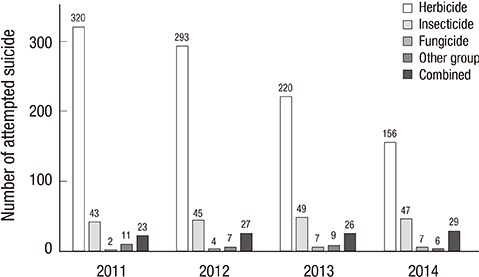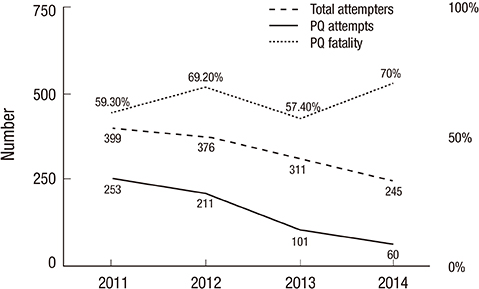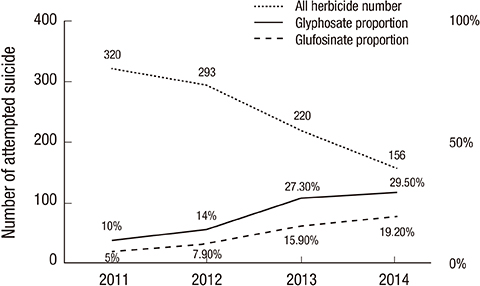J Korean Med Sci.
2015 Oct;30(10):1517-1521. 10.3346/jkms.2015.30.10.1517.
Common Pesticides Used in Suicide Attempts Following the 2012 Paraquat Ban in Korea
- Affiliations
-
- 1Department of Emergency Medicine, Soonchunhyang University Hospital, Cheonan, Korea.
- 2Department of Biostatistics, Soonchunhyang University Hospital, Cheonan, Korea.
- 3Department of Internal Medicine, Soonchunhyang University Hospital, Cheonan, Korea. syhong@sch.ac.kr
- KMID: 2344188
- DOI: http://doi.org/10.3346/jkms.2015.30.10.1517
Abstract
- To determine the change in pesticides used during suicide attempts after the 2012 paraquat (PQ) ban, we evaluated the annual number of suicide attempts by pesticide ingestion between 2011 and 2014. We extracted demographic, clinical outcome, and pesticide class data from the medical records of 1,331 patients that attempted suicide by pesticide ingestion. Pesticides were sorted into 5 groups: herbicides, insecticides, fungicides, other pesticides, and combined pesticides. Each group was subdivided into various classes based on publications by the respective Resistance Action Committees. The chi-square test for trends was used to compare the annual incidence of categorical variables. The total number of suicide attempts decreased each year, from 399 in 2011 to 245 in 2014. Simultaneously, PQ ingestion decreased from 253 patients in 2011 to 60 in 2014. The proportion of PQ to pesticides also decreased from 63.4% in 2011 to 24.5% in 2014. Furthermore, the rate of decrease in the proportion of PQ to all herbicide categories increased by calendar year. In conclusion, there is a significant trend in increased annual number of suicides and proportion of suicides using glyphosates and glufosinates versus total herbicides. However, the number of suicide attempts using glyphosate and glufosinate is lower than that using PQ. The ratio of persons completing suicide to those attempting suicide after pesticide ingestion has decreased every year after the PQ ban.
MeSH Terms
Figure
Cited by 2 articles
-
The Burden of Acute Pesticide Poisoning and Pesticide Regulation in Korea
Seulki Ko, Eun Shil Cha, Yeongchull Choi, Jaeyoung Kim, Jong-Hun Kim, Won Jin Lee
J Korean Med Sci. 2018;33(31):. doi: 10.3346/jkms.2018.33.e208.Effects of Paraquat Ban on Herbicide Poisoning-Related Mortality
Dong Ryul Ko, Sung Phil Chung, Je Sung You, Soohyung Cho, Yongjin Park, Byeongjo Chun, Jeongmi Moon, Hyun Kim, Yong Hwan Kim, Hyun Jin Kim, Kyung-Woo Lee, SangChun Choi, Junseok Park, Jung Soo Park, Seung Whan Kim, Jeong Yeol Seo, Ha Young Park, Su Jin Kim, Hyunggoo Kang, Dae Young Hong, Jung Hwa Hong
Yonsei Med J. 2017;58(4):859-866. doi: 10.3349/ymj.2017.58.4.859.
Reference
-
1. Wu KC, Chen YY, Yip PS. Suicide methods in Asia: implications in suicide prevention. Int J Environ Res Public Health. 2012; 9:1135–1158.2. Hvistendahl M. In rural Asia, locking up poisons to prevent suicides. Science. 2013; 341:738–739.3. van Spijker BA, Graafsma T, Dullaart HI, Kerkhof AJ. Impulsive but fatal self-poisoning with pesticides among South Asians in Nickerie, Suriname. Crisis. 2009; 30:102–105.4. Centers for Disease Control and Prevention (CDC). Suicide and attempted suicide: China, 1990-2002. MMWR Morb Mortal Wkly Rep. 2004; 53:481–484.5. Hong SY, Lee JS, Sun IO, Lee KY, Gil HW. Prediction of patient survival in cases of acute paraquat poisoning. PLoS One. 2014; 9:e111674.6. Gil HW, Hong JR, Jang SH, Hong SY. Diagnostic and therapeutic approach for acute paraquat intoxication. J Korean Med Sci. 2014; 29:1441–1449.7. Slater R, Ellis S, Genay JP, Heimbach U, Huart G, Sarazin M, Longhurst C, Müller A, Nauen R, Rison JL, et al. Pyrethroid resistance monitoring in European populations of pollen beetle (Meligethes spp.): a coordinated approach through the Insecticide Resistance Action Committee (IRAC). Pest Manag Sci. 2011; 67:633–638.8. Yin Y, Guo X, Zhang SL, Sun CY. Analysis of paraquat intoxication epidemic (2002-2011) within China. Biomed Environ Sci. 2013; 26:509–512.9. Tan JT, Letchuman Ramanathan G, Choy MP, Leela R, Lim BK. Paraquat poisoning: experience in hospital taiping (year 2008 - october 2011). Med J Malaysia. 2013; 68:384–388.10. Lee HL, Lin HJ, Yeh SY, Chi CH, Guo HR. Etiology and outcome of patients presenting for poisoning to the emergency department in Taiwan: a prospective study. Hum Exp Toxicol. 2008; 27:373–379.11. Cherukuri H, Pramoda K, Rohini D, Thunga G, Vijaynarayana K, Sreedharan N, Varma M, Pandit V. Demographics, clinical characteristics and management of herbicide poisoning in tertiary care hospital. Toxicol Int. 2014; 21:209–213.12. Nagami H, Maejima F, Nishigaki Y, Natsukawa S. Trends in paraquat poisoning in Japan - viewed from surveys on clinical cases. J Rural Med. 2013; 8:228–232.13. Seok SJ, Gil HW, Jeong DS, Yang JO, Lee EY, Hong SY. Paraquat intoxication in subjects who attempt suicide: why they chose paraquat. Korean J Intern Med. 2009; 24:247–251.14. Seok SJ, Park JS, Hong JR, Gil HW, Yang JO, Lee EY, Song HY, Hong SY. Surfactant volume is an essential element in human toxicity in acute glyphosate herbicide intoxication. Clin Toxicol (Phila). 2011; 49:892–899.15. Song HY, Kim YH, Seok SJ, Gil HW, Hong SY. In vitro cytotoxic effect of glyphosate mixture containing surfactants. J Korean Med Sci. 2012; 27:711–715.
- Full Text Links
- Actions
-
Cited
- CITED
-
- Close
- Share
- Similar articles
-
- Epidemiologic Characteristics of Intentional Poisoning: Emergency Department Based Injury in-depth Surveillance During 2011–2015
- A narrative review of contemporary lethal pesticides: unveiling the ongoing threat of pesticide poisoning
- Paraquat Intoxication in Subjects Who Attempt Suicide: Why They Chose Paraquat
- Clinical Characteristics of Non-Suicidal Self-Injury andSuicide Attempts among Psychiatric Patients in Korea:A Retrospective Chart Review
- The Characteristics of Suicide Attempts and Psychosocial Risk Factors in Correctional Institutions





